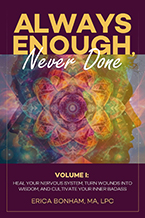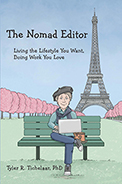March 8, 2025
Always Enough, Never Done
Volume I: Heal Your Nervous System, Turn Wounds Into Wisdom, and Cultivate Your Inner Badass
Erica Bonham
Aviva Publishing (2025)
Paperback ISBN: 978-1-63618-357-2
eBook ISBN: 978-1-63618-358-9
New Book Advocates Healing Nervous System for Greater Wellbeing
 Erica Bonham’s new book Always Enough, Never Done: Heal Your Nervous System, Turn Wounds Into Wisdom, and Cultivate Your Inner Badass is the first of two volumes that offer an insightful path to recovery that exceeds most of the recovery and personal development books out there. Erica, a Licensed Professional Counselor, certified EMDR (Eye Movement Desensitization and Reprocessing) clinician, consultant, and trainer believes that healing is possible for us all, but as her title proclaims, it is an ongoing process, so we must embrace it and continually work at it. While healing our pain is not easy, she also reminds us that “self-affirmationing your way out of trauma” doesn’t work. While affirmations are great, we also need to do the hard work.
Erica Bonham’s new book Always Enough, Never Done: Heal Your Nervous System, Turn Wounds Into Wisdom, and Cultivate Your Inner Badass is the first of two volumes that offer an insightful path to recovery that exceeds most of the recovery and personal development books out there. Erica, a Licensed Professional Counselor, certified EMDR (Eye Movement Desensitization and Reprocessing) clinician, consultant, and trainer believes that healing is possible for us all, but as her title proclaims, it is an ongoing process, so we must embrace it and continually work at it. While healing our pain is not easy, she also reminds us that “self-affirmationing your way out of trauma” doesn’t work. While affirmations are great, we also need to do the hard work.
Erica doesn’t mince words about what needs to be done, but she has such a great sense of humor and overall concept of the power of healing and owning your “inner badass” that reading this book is like having a best friend coaching you on your recovery.
The book is divided into six sections. That might seem like a lot, but each section is full of wisdom, humor, and practical advice and activities that will help you heal. This first volume is all about how to learn to relate to yourself on a deeper, more honest level. Volume II will address how to relate to other people, but the journey has to begin with ourselves. How you take that journey is largely up to you, however. Part of reconnecting with ourselves to learn to heal is learning to trust yourself, so Erica states, “I believe there are many paths; there are as many paths to truth, healing, recovery, and a vibrant life as there are human beings on the planet. Trust yourself. Trust what resonates, and let the rest of what I offer blow away with the breeze.”
Erica doesn’t shy away from using the big, heavy words. What many might call pain or dysfunction she refers to as “trauma.” She clarifies that why self-affirmations and many other processes don’t work is because trauma ends up in our bodies. At the end of the day, we can read all the books and do all the practices, but that trauma is going to stay in our system. One of Erica’s catch phrases is, “Trauma Doesn’t Give a S—t What We Know!”
To prove her point, Erica equates this idea with being a mom. She knows all the right parenting skills, but that doesn’t stop her from occasionally yelling at her kids when her nervous system is not regulated, causing her to react rather than pause to think. Add to that how we hold ancestral or generational trauma in our bodies and it’s no wonder how much we know doesn’t matter at times. Erica references Resmaa Menekem, who says we can carry fourteen generations of trauma encoded in our nervous systems. That amazes me. That means all the trauma of all our ancestors from about the mid-1600s onward may reside in our body, and if you do the math, that’s trauma from thousands of ancestors. That trauma affects how we react in our lifetime, and if we add to that all the painful things that happen to us, it’s a wonder we are functioning at all.
Erica begins in Section I with discussing our nervous system—how it works and “what’s f-ing it up.” Then in Section II, she discusses ways to calm your nervous system. She provides twenty-plus resources we can try out to help regulate our nervous system. She recommends we just use the ones that work for us. Some of these are simple physical exercises such as pushing our body against a wall, sighing, and shaking our body to release excess anxiety and energy. Others are more mental such as creating a mental allies team that might include characters from movies or books, people from your real life, or even animals, mythical creatures, and ancestors, whom you imagine being there to support you. I especially loved this idea because I’ve thought about it myself. I am sure Tarzan, King Arthur, and Papa Smurf are all on my team.
The sections that follow teach us how to create a healthy relationship with ourselves, how unhealed pain can lead to having a shame-based identity and body image, how to cultivate a healthy relationship with our bodies, how to cultivate self-awareness to process our pain, and ultimately, how to empower ourselves.
Erica’s discussion on body shaming was particularly interesting to me. I especially appreciated her acknowledgment that “if we are in a body of color, a queer body, an impoverished body, a disabled body, a female-identified body, a trans body, or a bigger body, living in a world that doesn’t respect, center, or validate our experience is also traumatic.” She then discusses how we can overcome a lot of that trauma.
Unfortunately, I can’t discuss everything in this book, but I’ll touch on just a few more highlights. Erica discusses the importance of “both-and work.” For example, we can radically accept that parts of us struggle with body image and still try to shed our need to hold on to perfectionism, comparing ourselves to others, and ridiculous, unattainable body standards.
In Section V, Erica delves into shadow work and grief work. She also discusses how our negative beliefs helped us survive in the past and what to do with them now, plus the difference between toxic shame and healthy guilt.
One of the most eye-opening discussions in the book for me was when Erica discussed how when she works with abuse survivors, they feel that as bad as the abuse was, it’s just as bad when people don’t acknowledge the abuse, especially in families where the abuse isn’t talked about. She states that when trauma is unacknowledged, it gives the message that “This terrible thing that happened to you is something you should be ashamed of.” Not bringing the truth to light that the abuse happened will only cause further havoc in our lives.
Always Enough, Never Done is loaded with more powerful information for you to think about and apply so you can heal. Rather than continue to discuss it, I encourage you to read the book. Let me just end with one more quote from Erica:
“What is already and always true is you are enough, lovable, and connected, and you can and want to learn, stay humble, and know you have areas in which you can grow. Everything you want to grow into, everything you want to become, is already and always true, and it is already inside you. You are always enough and never done.”
For more information about Erica Bonham and Always Enough, Never Done, visit www.avoscounseling.com.
— Tyler R. Tichelaar, PhD and award-winning author of The Mysteries of Marquette

